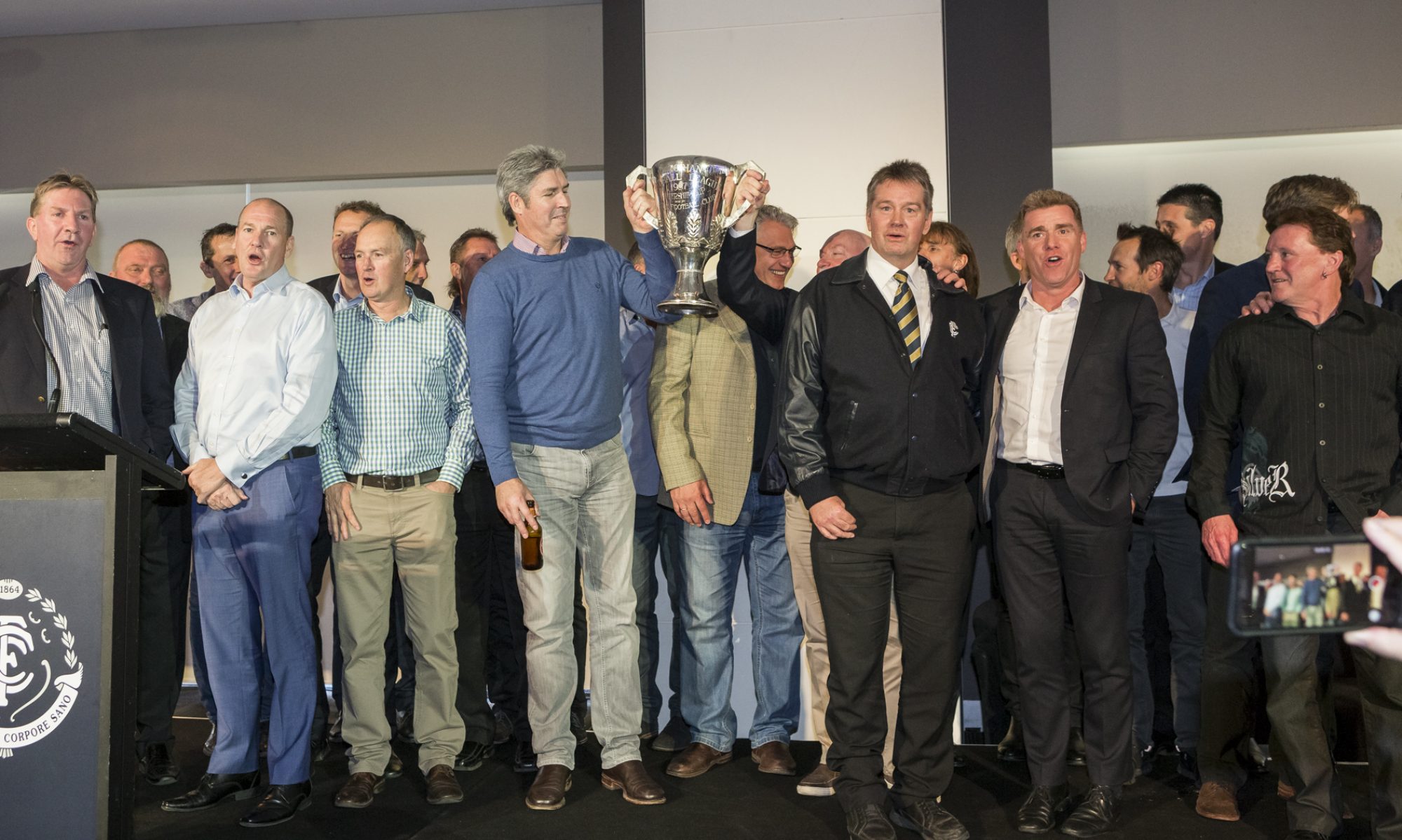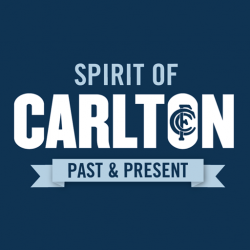By Tony De Bolfo
Precious film footage of the final quarter of the 1969 round two match between Carlton and Hawthorn – when the Blues banged on 12.6 to record the historic scoreline of 30.30 (210) – has been delivered from oblivion and conveyed to the football club’s archive.
The matchday film, thought lost, was shot by the cameramen of HSV7 and featuring the commentary of Frank Adams and the late Jack Edwards. The film was discovered on one of two 16mm reels retrieved from a dumpmaster years ago after the network apparently saw fit to discard much of its home and away matchday footage.
This week, the reels were generously handed over by Carlton enthusiast John Dickens, who had kept them in his possession since 2004.
“I know this seems hard to believe, but it’s the truth. About eight years ago I was given the reels by a friend who told me he found them in a skip. He knew I had access to 16mm projectors and was a Carlton fan,” said Dickens.
“I was amazed when I saw the footage and arranged through a friend, who had contacts at a post-production house, to have them converted to video and then to disk. During the conversion I realized they were probably archival footage of old videotapes and I’ve had them kicking around for a long time.”
When asked why he had come forward with the film now, Dickens replied with a question of his own. “Who owns the footage?”.
“I think the people own it – the clubs, the players, the fans and no one individual – and any way that other people can get to see it has got to be a good thing,” he said.
The extraordinary film, in which the since-demolished Garton Street scoreboard and Robert Heatley Stand can be seen, features moments of sheer brilliance from the likes of Brent Crosswell, Adrian Gallagher, Alex Jesaulenko and John Nicholls.
Carlton’s three-time premiership coach David Parkin, at that time Hawthorn ’s besieged back pocket, also features in the film – as does full-forward Peter Hudson and the late Peter Crimmins.

The film ends with Ian Robertson’s towering mark over “Parko” and dramatic post-siren conversion – Carlton’s 12th goal for the quarter and 30th for the match – on an afternoon in which his team registered a 128-point win and became the first in League history to post a 200-point score.
Little wonder Jack Edwards is heard to say “I’ve never seen a side treat another side with such contempt”.
Robertson, whose 125-game career at Carlton encompassed three premierships, was delighted to learn that film footage of this momentous occasion in Carlton history had surfaced after all these years – not that time had dimmed his memory.
“I can remember that early on ‘Barass’ (Ron Barassi) told Brent Crosswell to man up on Des Meagher, because he was quickly booting the ball forward to (Peter) Hudson,” said Robertson, who himself called matches for the Seven Network.
“Brent did a great job and by three-quarter time we were a mile in front, so Barass gave Crosswell his head . . . and if you check the replay I reckon Brent’s kicked four goals in the last quarter.
“I do remember kicking goal number 30. I didn’t play on it, but I used to tell people ‘We kicked a record score and I kicked the 30th’.”
Carlton’s 30.30 (210) – a League record which stood for 20 years – bettered its previous highest score of 28.10 (178) amassed against Collingwood at Victoria Park in Round 12, 1943.
Today, almost 43 years after the event, it remains the highest score accumulated by a Carlton team.

The other reel generously donated to the club by Dickens is no less interesting. It contains footage of the first quarter of the Round 4 fixture between Carlton and Melbourne at the MCG, when the then captain-coach Ron Barassi, up against his former club, boots the first goal after just 90 seconds and John Nicholls poleaxes the Redlegs half-back Tony Anderson.
Bairnsdale’s Bob Edmond and the St Kevin’s schoolboy Peter Kerr, both on debut, can be seen on the bench in their dressing gowns waiting for Barassi’s nod, while Maffra’s John Leatham turns out for what would be his second and final appearance in a dark Navy Blue guernsey.
The Carlton team versus Hawthorn, Round 2, Saturday, April 12, 1969, Princes Park:
Backs: Ian Collins, Wes Lofts, Kevin Hall
Half-Backs: John Goold, Robert Walls, Barry Gill
Centres: Garry Crane, Syd Jackson, Ian Robertson
Half-forwards: Alex Jesaulenko, Brent Crosswell, Bryan Quirk
Forwards: Peter Jones, Ron Stone, Ian Nicoll
Rucks: John Nicholls, Sergio Silvagni, Adrian Gallagher
Reserves: Vin Waite, Peter Kerr
Coach: Ron Barassi
Carlton 6.6 13.17 18.24 30.30 (210)
Hawthorn 3.2 6.4 10.10 12.10 (82)
Goalkickers: Jones (7.3), Jesaulenko (6.12), Crosswell (4.2), Quirk (3.4), Robertson (3.0), Gallagher (2.3), Nicholls (2.1), Nicoll (2.1), Stone (1.1), Hall (0.1), Jackson (0.1), rushed (0.1)
Best: Jesaulenko, Jones, Gallagher, Robertson, Nicholls, Collins, Lofts
Reports: Lofts (striking), suspended four matches
Injuries: Goold (bruised hip), Stone (slight concussion)
Field umpire: Jeff Crouch
Attendance: 25,894 at Princes Park










